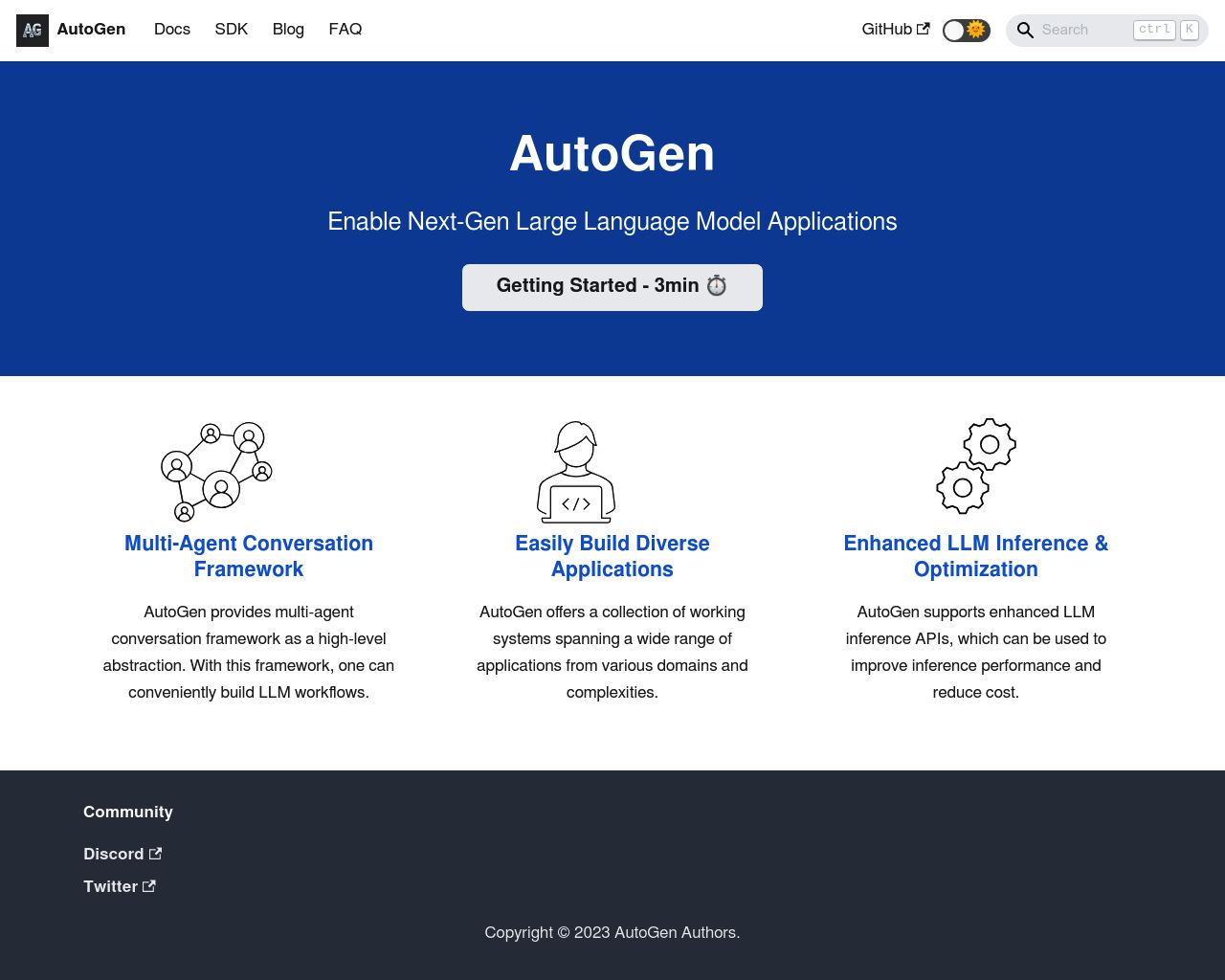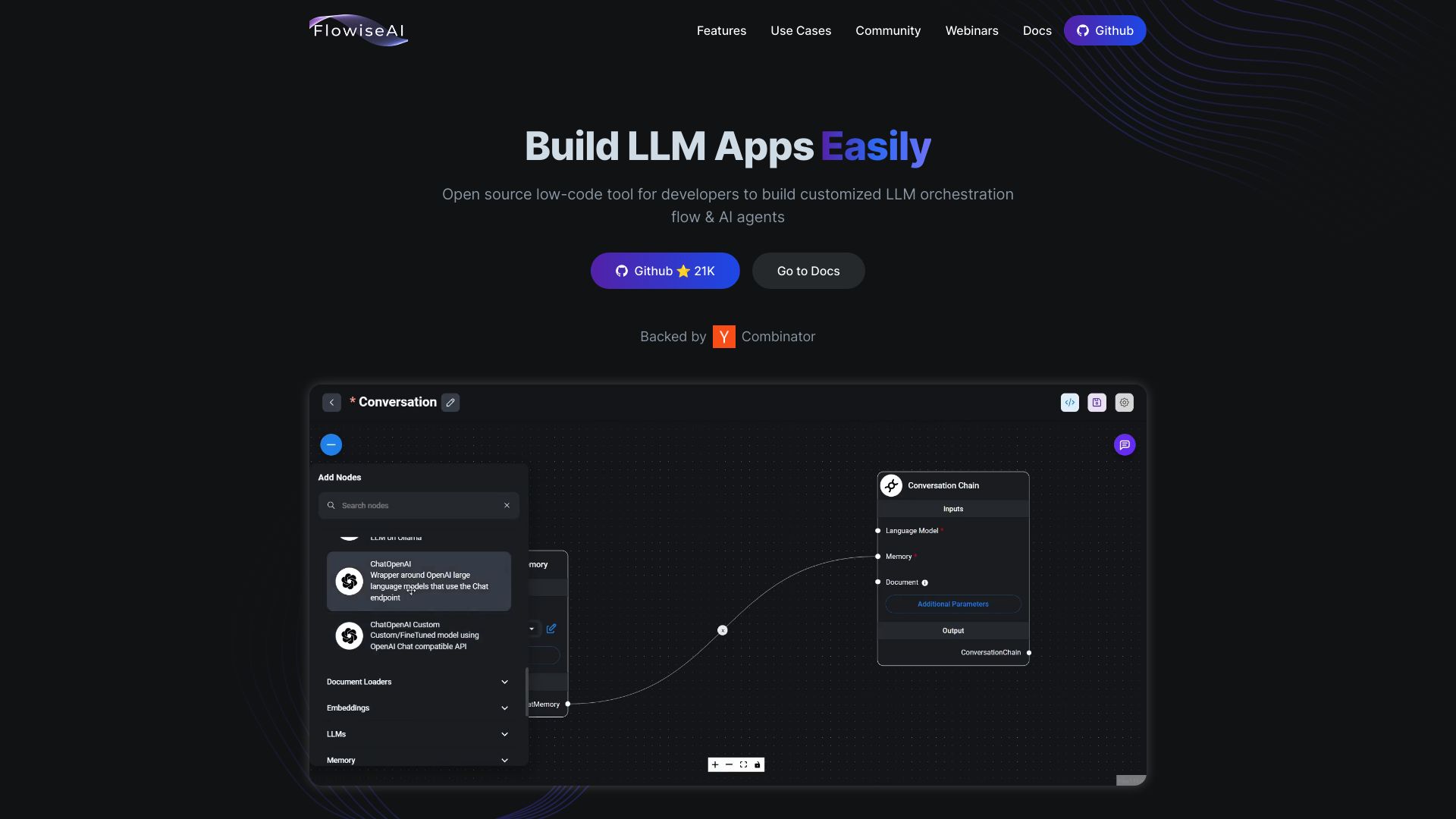AI development platforms AutoGen and FlowiseAI offer powerful tools for creating sophisticated AI applications, but each comes with distinct trade-offs. AutoGen shines in multi-agent systems and complex problem-solving, while FlowiseAI’s low-code interface speeds up prototyping and deployment. This comparison dives deep into their capabilities, exploring how they stack up against SmythOS—a platform that combines intuitive design with advanced features. We’ll examine each tool’s strengths in AI orchestration, security measures, and deployment options, helping you choose the best fit for your AI development needs. Whether you’re a seasoned developer or new to AI, this analysis provides the insights to make an informed decision in today’s competitive AI landscape.
AutoGen Overview
AutoGen empowers developers to create sophisticated Large Language Model (LLM) applications through multi-agent conversations. The framework enables customizable agents to interact with each other, LLMs, tools, and humans to tackle complex tasks.

AutoGen maximizes LLM performance with enhanced inference capabilities, including tuning, caching, error handling, and templating. This optimization proves crucial for leveraging expensive models like ChatGPT and GPT-4 effectively. The platform supports both autonomous agent operations and human-in-the-loop problem-solving, offering flexibility for applications requiring human input.
AutoGen maximizes LLM performance with enhanced inference capabilities… This optimization proves crucial for leveraging expensive models like ChatGPT and GPT-4 effectively.
Developers can tailor agents to specific task requirements, integrating LLMs, human inputs, and various tools. AutoGen demonstrates effectiveness across diverse applications, from automated task solving and code generation to continual learning and complex problem-solving in group chats. The framework includes debugging tools and logging functionalities for API calls, essential for diagnosing and optimizing LLM-based systems.
While AutoGen offers powerful capabilities for LLM-driven applications, it requires coding knowledge for setup and configuration. The lack of a visual builder or no-code editor may present a barrier for non-technical users. Additionally, the framework’s focus on code-based solutions might limit accessibility for those seeking drag-and-drop interfaces or pre-built templates commonly found in other AI agent builders.
FlowiseAI Overview
FlowiseAI empowers developers to create customized large language model orchestration flows and AI agents through an open-source, low-code platform. This innovative tool simplifies the process of building sophisticated AI applications without requiring deep technical expertise in artificial intelligence.

FlowiseAI’s intuitive drag-and-drop interface enables rapid prototyping and deployment of AI solutions. Developers can customize Large Language Model orchestration flows to address specific needs across various applications, from document analysis to customer support. The platform’s modular approach, using an agent and chain system, allows users to link different components like document loaders, text splitters, and Large Language Models to create complex workflows.
FlowiseAI’s intuitive drag-and-drop interface enables rapid prototyping and deployment of AI solutions. Developers can customize Large Language Model orchestration flows to address specific needs across various applications…
Key features of FlowiseAI include integration capabilities with various document loaders and vector databases, support for multiple data types (PDFs, web pages, CSV files), and pre-built templates for common AI tasks. These features make FlowiseAI versatile and applicable to a wide range of use cases. The platform also supports conversational retriever QA chains for question-answering applications, enhancing its utility in interactive AI scenarios.
While FlowiseAI offers significant advantages in terms of ease of use and customization, it may have limitations in areas such as advanced debugging tools or extensive multimodal capabilities. The platform’s focus on low-code development, while beneficial for rapid prototyping, might pose challenges for users requiring highly specialized or complex AI implementations that go beyond the provided visual interface.
FlowiseAI’s vision centers on democratizing AI development by making it accessible to a broader audience. By lowering the barrier to entry for AI application development, FlowiseAI aims to enable more individuals and organizations to harness the power of large language models. This approach positions FlowiseAI as a valuable tool for various industries looking to implement AI solutions quickly and efficiently, particularly for those without extensive AI development resources.
FlowiseAI’s vision centers on democratizing AI development by making it accessible to a broader audience. By lowering the barrier to entry for AI application development…
Feature Comparison
AutoGen and FlowiseAI offer distinct approaches to AI agent development, each with its own strengths and limitations. AutoGen excels in creating sophisticated multi-agent systems capable of complex problem-solving and collaboration. Its framework supports autonomous operations and human-in-the-loop interactions, making it versatile for various applications. AutoGen’s enhanced Large Language Model inference capabilities, including tuning and caching, optimize performance for expensive models like GPT-4.
FlowiseAI, on the other hand, focuses on providing a low-code, visual interface for building AI workflows. Its drag-and-drop functionality and pre-built templates make it more accessible to users without extensive coding knowledge. FlowiseAI’s strength lies in its ability to quickly prototype and deploy AI solutions, particularly for document analysis and conversational AI applications. However, it may lack some of the advanced debugging tools and extensive multimodal capabilities found in AutoGen.
In terms of security and deployment options, both platforms have gaps compared to SmythOS. Neither AutoGen nor FlowiseAI offer robust features for data encryption, IP control, or constrained alignment of AI behavior. SmythOS provides these critical security measures, ensuring better protection and control over AI deployments. Additionally, SmythOS offers more comprehensive deployment options, including site chat and scheduled agent functionalities, which are not explicitly mentioned in AutoGen or FlowiseAI’s feature sets.
Feature Comparison Table
| AutoGen | FlowiseAI | SmythOS | |
|---|---|---|---|
| CORE FEATURES | |||
| Hosted Agents (Dev, Production) | ✅ | ❌ | ✅ |
| Environments (Dev, Production) | ✅ | ❌ | ✅ |
| Visual Builder | ❌ | ✅ | ✅ |
| No-Code Options | ❌ | ✅ | ✅ |
| Debug Tools | ✅ | ❌ | ✅ |
| Multi-Agent Collaboration | ✅ | ❌ | ✅ |
| Audit Logs for Analytics | ✅ | ❌ | ✅ |
| Work as Team | ✅ | ❌ | ✅ |
| Agent Work Scheduler | ❌ | ✅ | ✅ |
| SECURITY | |||
| Constrained Alignment | ❌ | ❌ | ✅ |
| OAuth | ✅ | ❌ | ✅ |
| IP Control | ❌ | ❌ | ✅ |
| COMPONENTS | |||
| Zapier APIs | ✅ | ❌ | ✅ |
| Classifiers | ✅ | ❌ | ✅ |
| Data Lakes | ❌ | ❌ | ✅ |
| DEPLOYMENT OPTIONS (EMBODIMENTS) | |||
| Staging Domains | ❌ | ❌ | ✅ |
| Production Domains | ❌ | ❌ | ✅ |
| Deploy as Scheduled Agent | ❌ | ❌ | ✅ |
| DATA LAKE SUPPORT | |||
| Hosted Vector Database | ❌ | ❌ | ✅ |
| Sitemap Crawler | ❌ | ❌ | ✅ |
| YouTube Transcript Crawler | ❌ | ❌ | ✅ |
| Word File Support | ✅ | ❌ | ✅ |
Conclusion
AutoGen and FlowiseAI offer powerful capabilities for AI development, but SmythOS stands out as the superior choice. AutoGen excels in creating sophisticated multi-agent systems, while FlowiseAI provides a user-friendly low-code interface. However, both platforms lack critical features that SmythOS delivers.
SmythOS combines the best of both worlds, offering an intuitive drag-and-drop interface with advanced multi-agent capabilities. Our platform provides robust security measures, including data encryption and IP control, addressing the gaps in AutoGen and FlowiseAI. SmythOS also offers more comprehensive deployment options, such as site chat and scheduled agents, expanding the possibilities for AI integration.
For developers and businesses seeking a versatile, secure, and user-friendly AI development platform, SmythOS is the clear choice. Our extensive feature set, including multimodal support, problem-solving capabilities, and seamless integrations, empowers users to create sophisticated AI solutions efficiently. Explore our diverse range of AI-powered agent templates to jumpstart your AI development journey.
Ready to experience the future of AI development? Create a free SmythOS account today and unlock the full potential of AI for your projects. With our 30-day money-back guarantee and unlimited agent creation, you can start building powerful AI solutions risk-free. Deploy SmythOS Agents Anywhere and revolutionize your workflow with the most advanced AI platform available.